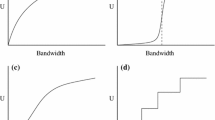Abstract
We consider the performance of a network like the Internet handling so‐called elastic traffic where the rate of flows adjusts to fill available bandwidth. Realized throughput depends both on the way bandwidth is shared and on the random nature of traffic. We assume traffic consists of point to point transfers of individual documents of finite size arriving according to a Poisson process. Notable results are that weighted sharing has limited impact on perceived quality of service and that discrimination in favour of short documents leads to considerably better performance than fair sharing. In a linear network, max–min fairness is preferable to proportional fairness under random traffic while the converse is true under the assumption of a static configuration of persistent flows. Admission control is advocated as a necessary means to maintain goodput in case of traffic overload.
Similar content being viewed by others
References
M.F. Arlitt and C. Williamson, Web server workload characterization: The search for invariants, in: Proc. of ACM Sigmetrics'6 (1996).
F. Baccelli and P. Brémaud, Elements of Queueing Theory, Applications of Mathematics, Vol. 26 (Springer, New York, 1994).
D. Bertsekas and R. Gallager, Data Networks (Prentice-Hall, Englewood Cliffs, NJ, 1987).
M. Crovella and A. Bestavros, Self-similarity in World Wide Web traffic: Evidence and possible causes, in: Proc. of ACM Sigmetrics'6 (1996).
G. Fayolle, I. Mitrani and R. Iasnogorodski, Sharing a processor among many jobs, Journal of the ACM 27(3) (1980) 519–532.
D. Heyman, T. Lakshman and A. Neidhart, A new method for analysing feedback-based protocols with application to engineering Web traffic over the Internet, in: Proc. of ACM Sigmetrics'7 (1997).
F. Kelly, Charging and rate control for elastic traffic, European Transactions on Telecomunications 8 (1997) 33–37.
F. Kelly, A. Maulloo and D. Tan, Rate control for communication networks: Shadow prices, proportional fairness and stability, Journal of the Operational Research Society 49 (1998).
L. Kleinrock, Queueing Systems, Vol. 2 (Wiley, New York, 1975).
V.P. Kumar, T.V. Lakshman and D. Stiliadis, Beyond best effort: Router architectures for differentiated services of tomorrow's Internet, IEEE Communications Magazine 36(5) (1998).
L. Massoulié and J. Roberts, Bandwidth sharing: Objectives and algorithms, in: Proc. of IEEE Infocom'9 (1999).
L. Massoulié and J. Roberts, Arguments in favour of admission control for TCP flows, in: Proc. of ITC 16, eds. P. Key and D. Smith, Teletraffic in a Competitive World (North-Holland, Amsterdam, 1999).
E. Oubagha, L. Massoulié and A. Simonian, Delay analysis of a credit-based control for ABR transfer, in: IEEE ATM'7 Workshop (1997).
J. Roberts, Quality of service guarantees and charging in multiservices networks, IEICE Transactions on Communications, Special issue on ATM Traffic Control and Performance Evaluation E81-B(5) (1998).
L. Schrage and L. Miller, The M/G/1 queue with the shortest remaining processing time first discipline, Operations Research (1966) 670–684.
S. Shenker, Fundamental design issues for the future Internet, IEEE Journal on Selected Areas in Communications 13(7) (1995).
Author information
Authors and Affiliations
Rights and permissions
About this article
Cite this article
Massoulié, L., Roberts, J. Bandwidth sharing and admission control for elastic traffic. Telecommunication Systems 15, 185–201 (2000). https://doi.org/10.1023/A:1019138827659
Issue Date:
DOI: https://doi.org/10.1023/A:1019138827659




